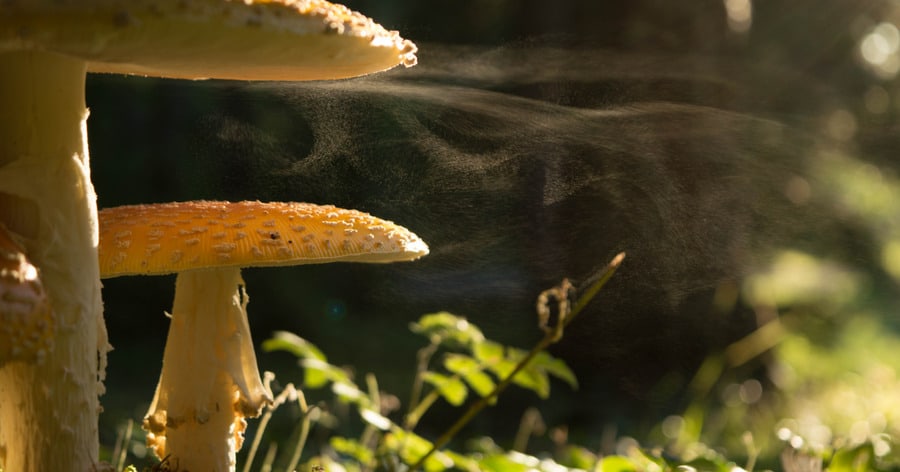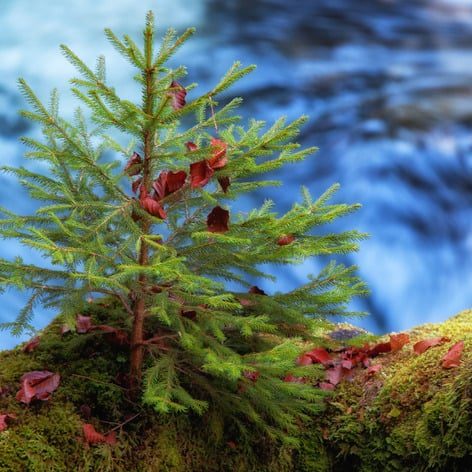Share:
Fungi restoring ecosystems and climate: Rewilding from the bottom up

The microclimate plays a crucial role in the growth of fungi, with mushrooms and mycelium in the soil thriving in a cool, moist, and shaded environment.
However, these organisms also have the capability to modify their microclimate when it is not favorable to their growth. Mushrooms play important roles in regulating microclimates.
Airconditioning
Have you ever wondered how mushrooms can spread their spores without the help of a breeze? Scientists have uncovered their remarkable secret: they create wind themselves. Through evaporation, mushrooms manipulate their microclimate, leading to an increase in air humidity and a drop in temperature. This creates a dense air zone and small wind currents around the mushroom, allowing it to distribute its spores through the air. This means that mushrooms can effectively disperse their spores even in still conditions.

The research also showed that the air temperatures around different mushrooms were 1-2°C lower than the ambient air, with the mushrooms themselves being around 4°C cooler. This reduction in temperature is due to the energy consumption required for evapotranspiration.
Rainmakers
Mushrooms have a surprising ability to create rain. They release millions of tons of fungal spores into the air, which are among the largest living particles. These spores, along with plant pieces and pollen grains, can serve as the nucleus for water condensation in clouds. When water condenses on the spore surfaces, it forms rain droplets. This means that large populations of fungi can contribute to rainfall in their ecosystems.

This creates a positive feedback loop: the growth of fungi is stimulated by rain, leading to the release of large quantities of spores that further enhance precipitation. By this mechanism, mushrooms play a crucial role in promoting rainfall in the environments they inhabit.
Mycorrhiza
Nearly 90% of plant species, including crops, have symbiotic relationships with fungal networks. These relationships give plants the power to access nutrients in the soil, making fungi critical in soil building. They release nutrients in a form that can be absorbed by plant roots, reduce the risk of nutrient loss through leaching, and improve drought resilience by redistributing water to upper soil layers.

Moreover, fungal networks also play a crucial role in carbon sequestration. Ecosystems with healthy fungal networks store more carbon than those without, improving soil quality and drought tolerance, and increasing overall resilience.
Cascading impact
According to renowned mycologist and author Paul Stamets, a strain of Oyster mushrooms has the ability to clean up crude oil. In a scientific study, Stamets showed that the mushrooms were able to break down over 95% of harmful polycyclic aromatic hydrocarbons (PAHs) into non-toxic components. Not only were the mushrooms effective in cleaning up oil spills, but they also contributed to the restoration of the surrounding environment.
Once the mushrooms began to rot, they attracted flies, leading to a chain of events where other insects and birds were drawn in, ultimately bringing in seeds to the previously polluted area. Through this process, the mushrooms played a vital role in facilitating habitat remediation and restoring the ecosystem. Stamets’ research highlights the remarkable abilities of fungi in promoting environmental sustainability.
Ecosystem restoration

Mycorrhizal fungi and mushrooms have a vital role in maintaining ecological stability and fostering growth in ecosystems. With their ability to regulate weather and their adaptive mechanisms, they serve as keystone organisms in dynamic environments. As such, they can be leveraged to restore, rejuvenate, and heal ecosystems, local climates and agricultural land. That’s why the Rewilding Academy promotes a symbiotic partnership between fungi, rewilders, and farmers.
For more information, please watch our webinar recording on fungi and rewilding.
Photo: Sasha Panarin / Scop.io






